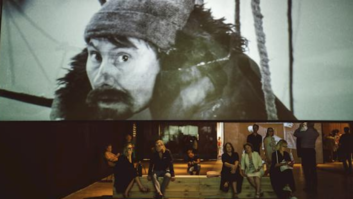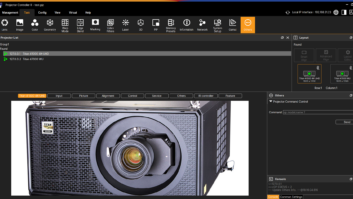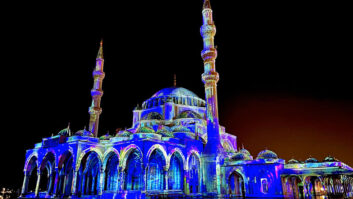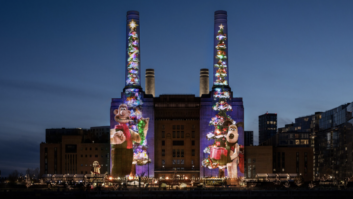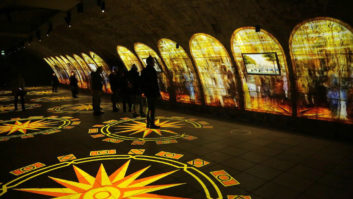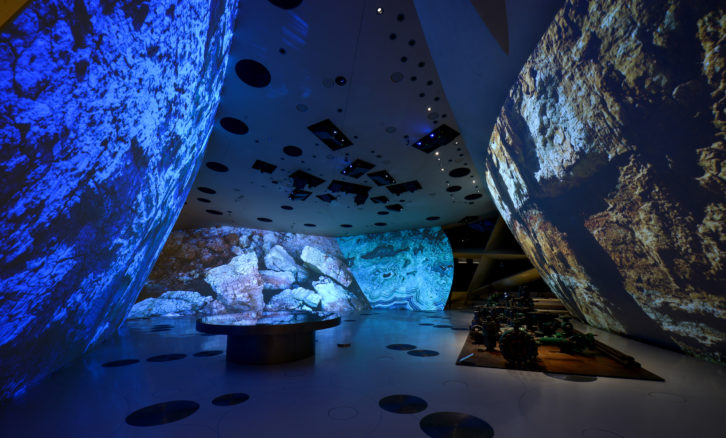
It has been a while since projection mapping was merely seen as ‘guerilla PR’ for marketeers. Sure, it’s still the go-to approach for many public relations outfits if they’re looking to make some relatively easy noise for clients, but in the last 2-3 years mapping has broadened its remit considerably.
Rapid advances in technological innovations have removed many of projection mapping’s previous restrictions, with environments that would have previously been ruled out more easily accommodated – with mapping onto moving targets now possible. For marketeers and technologists this has opened up the demand for projection mapping to a much wider client base than was previously the case.
“The development of video mapping has been incredible over the last three years,” says Pierre-Yves Toulot, CEO, Whatsit. “Thanks to numerous technological innovations and competition extended to several brands of devices, we have witnessed a democratisation of the technology required for video mapping.” Toulot also cites the emergence of multiple projection mapping festivals and the emergence of a growing number of studios and artists in many different countries as having a major impact on its ongoing success.
“Over the past few years we’ve seen artists, integrators and venues embrace projection mapping as a powerful medium to tell a story and augment their world,” adds Shawn Mills, senior manager, advanced research & collaboration at Christie. “There are some incredible artists in the industry that are really pushing the boundaries; whether it be in small exhibits all the way up to large scale theme park deployments – keeping up with them is the key. Creatives can play off certain architectural elements, highlight unique features or deliver a message in a way that the audience isn’t quite expecting. This ability is extremely powerful and we’re seeing much larger scale experiences and a desire to build them even bigger.”
“Over the past few years we’ve seen artists, integrators and venues embrace projection mapping as a powerful medium to tell a story and augment their world”
Shawn Mills, Christie
As the market has evolved there has also been opportunities to build technology in a way that truly addresses customer requirements. “If you try to force an existing product to fit a market, you have a problem,” says Mills. “Rather, if you listen to your customers and strip out what’s not needed while adding things that address their problems, they no longer need to worry about the equipment and can concentrate on the experience.”
Increasingly sophisticated
The art of projection mapping has certainly become increasingly sophisticated over the last few years, with more tools available to deliver more complex concepts. Motion capture and real-time tracking have made a big difference in helping to deliver more immersive mapping experiences to large audiences.
“Add these other technologies and now you have large-scale, interactive experiences for the masses,” explains Emma Bigg, director at consultants Octavius RE. “I also think there is increasing appreciation for the skill set involved in some of the more breathtaking installations we have seen in recent years – and as a result more projection specific platforms are available to support this work.”
“The technology has developed so rapidly that creative concepts are given much more possibilities for implementation,” adds Niko Hocke, managing director at macom NIYU. “With powerful projectors and powerful high-performance computers, in combination with the latest software developments, it is possible to create more brilliant and sharper mapped images. Any limitations are in terms of content creation, as the amount of data is becoming increasingly gigantic to produce and handle.”
With technology becoming more streamlined and efficient, costs have come down, helping to further broaden mapping’s reach, although content creation is, unsurprisingly, the biggest draw on today’s projection mapping budgets.
“It is now relatively simple to produce content that creates a wow-factor experience for live events,” explains Alicia Earls, client relationship and communications manager, White Light. “While content creation is still the biggest budget consideration, there are cost-effective ways to repurpose archive assets and use the inherent architecture of a venue as a canvas.”
Complementary innovation
And while content creation is, for most, the biggest budgetary concern, the innovations in projection mapping’s rise have come from both hardware and software innovations. “Innovations in both hardware and software in the projection mapping industry are very complementary,” says Mills. “As you can imagine, software seems to be evolving at a much faster rate, and this has been even more apparent over the last few years. If you imagine the hardware as the raw horsepower, then it’s a logical extension that the software is the critical piece that holds it all together.”
“Advances are thanks to improvements in both the hardware and software used for projection mapping,” adds Peter Jones, operations director, Anna Valley. “Projection has been completely reinvented over the last few years through a series of incremental changes in the hardware that, collectively, have smashed away traditional restrictions.
“The recent increase in processing power of the servers that feed and control the content and the improvements in the software that allow us to manipulate it are also key to the advances in projection mapping. We’re now able to respond to real-world inputs and render content in real time, which means that projection mapping can be responsive to its environment, opening up so many creative possibilities.”
Replacing lamp projectors with more reliable laser phosphor projectors has certainly reduced both the physical space needed for projection mapping setups, and the cost of projects. Lens development has also made a difference, with projectors now able to be positioned almost anywhere without compromising image quality.
Periscope lenses allow for the bending of light, to enable the projector to be set up above or below the surface that it’s projecting onto, and 4K projectors provide a much more realistic image with less pixelation. “All these advancements mean that projection mapping can be deployed more widely for a greater range of applications,” says Bigg. “It is no longer just the preserve of large budget events.”
Projectors are certainly brighter; they have also become more compact and more energy efficient, especially with the advances in laser technology. “This means you can achieve complex projections with fewer projectors and less energy making the installation more cost effective and simpler,” explains Bigg. “And in concert with the optics, on-board processing has also moved on, with many projectors having on-board features that would normally sit on the server.”
www.annavalley.co.uk
www.christiedigital.com
www.macom.de
www.octaviusre.com
www.optoma.com
www.whatsit.fr/en
www.whitelight.ltd.uk
